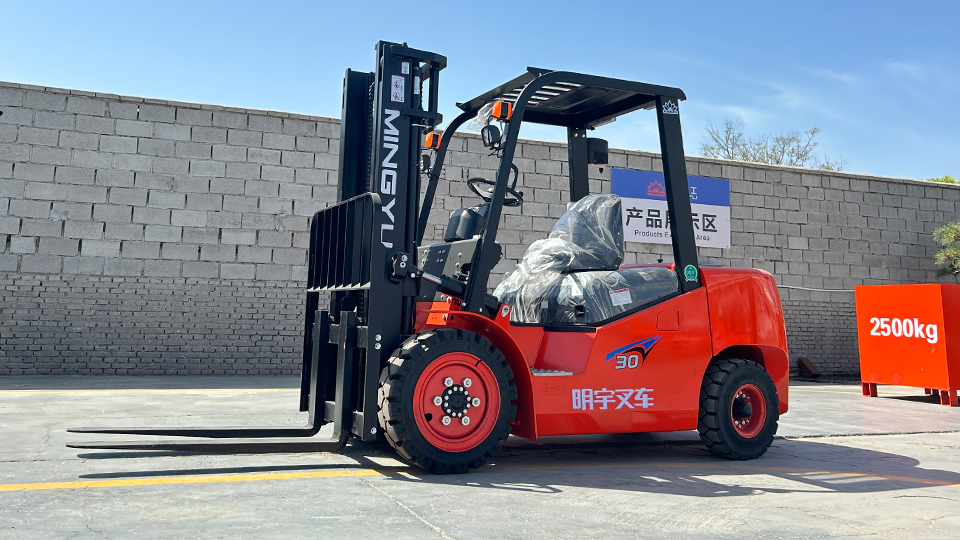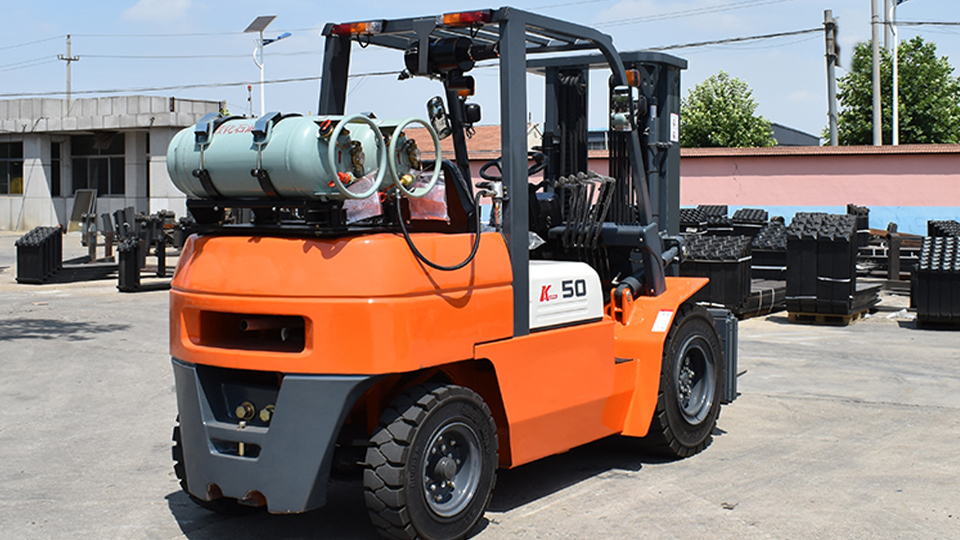
What is the Fuel Tank Capacity of a Forklift? A 2025 Technical Guide
Forklift fuel tank capacity is not a one-size-fits-all specification. It is a engineered variable that is tightly coupled to truck class, engine displacement, duty cycle, and the chemical energy density of the fuel itself. In 2025, the market spans 3,000 lb electric pallet trucks with no liquid fuel on board to 48,000 lb diesel container handlers that carry more than 110 gal (450 L) of ultra-low-sulfur diesel (ULSD). This article dissects the topic from first principles, presents OEM data gathered in October 2025, and gives logistics engineers the equations they need to predict real-world operating range.
1. Why tank capacity matters
Fuel tank volume determines:
Shift autonomy – how many hours a truck can operate before the operator must refuel
LCG (load center of gravity) – a larger tank moves the center of gravity rearward, affecting stability when the mast is elevated
Floor loading – diesel weighs 7.1 lb/gal at 15 °C; 30 gal adds 213 lb to the service weight
CAPEX vs. OPEX trade-off – a bigger tank raises acquisition cost but lowers labor cost for refueling stops
For these reasons, manufacturers size tanks so that the average truck consumes 90–95 % of its fuel in a standard 8 h shift plus a 10 % safety reserve. The “safe-fill” rule (95 % of nominal volume) is written into UL 142, ISO 3779, and EU 2018/985.
2. Fuel energy density and forklift duty cycle
Fuel type (25 °C) Lower heating value Density Energy per liter Typical tank pressure

Diesel (ULSD) 42.8 MJ/kg 0.845 kg/L 36.2 MJ/L atmospheric
LPG (propane) 46.3 MJ/kg 0.507 kg/L 23.5 MJ/L 8–10 bar @ 45 °C
Gasoline (E10) 43.2 MJ/kg 0.745 kg/L 32.2 MJ/L atmospheric
H₂ (350 bar) 120 MJ/kg 0.024 kg/L 2.9 MJ/L 350 bar
A diesel forklift that consumes 2.5 L/h therefore needs 18 L of tank volume for an 8 h shift if refueling occurs daily. The same truck converted to LPG would need 28 L because of the lower volumetric energy. OEMs enlarge LPG tanks or accept shorter range.
3. Capacity by forklift class (2025 production data)
The Industrial Truck Association (ITA) classes are used worldwide:
ITA class Nominal capacity Typical engine Tank range (2025 models)
I – Electric 3,000–12,000 lb battery only 0 L liquid fuel
II – Narrow-aisle 2,500–5,500 lb battery only 0 L
III – Pallet 2,000–8,000 lb battery only 0 L
IV – Cushion LPG 3,000–15,500 lb PSI 2.4 L/K21 57–76 L (15–20 gal)
V – Pneumatic IC 3,000–35,000 lb 2.2–4.5 L diesel 60–110 L (16–30 gal)
VI – Towing 10,000–200,000 lb tug 3.0 L diesel 80–120 L
VII – Rough terrain 5,000–12,000 lb 3.8–4.5 L diesel 80–120 L (21–32 gal)
VIII – Container 40,000–80,000 lb 8.9–12 L diesel 200–450 L (53–119 gal)
Note: Classes I–III are battery-electric; capacity is expressed in kWh (10–80 kWh lithium-ion in 2025).
4. OEM tank specifications (October 2025)
The following data were extracted from operator manuals and type-approval sheets released between January and September 2025.
4.1 Diesel counterbalance (Class V)
Model Rated load Engine Tank (nominal) Tank (safe-fill) AdBlue
Toyota 8FG35U 7,000 lb 1KD-FTV 3.0 L 70 L 66.5 L 12 L
Cat DP50N2 11,000 lb C4.4 ACERT 4.4 L 80 L 76 L 15 L
Hyster H50-12FT 10,000 lb Kubota V3800 3.8 L 100 L 95 L 18 L
Hangcha CPCD35-A2 7,700 lb Xinchai 4D27G 2.7 L 70 L 66.5 L none
JAC CPCD30J 6,600 lb C240PKJ 2.4 L 60 L 57 L none
Mitsubishi FD40 8,800 lb 4D34 3.4 L 60 L 57 L none
4.2 LPG cushion / pneumatic (Class IV)
Model Rated load Engine LPG tank Vaporizer Notes
Cat DP40K 8,000 lb K21 LPG 57 L (15 gal) IMPCO 200 Vapor withdrawal
Toyota 8FGC35 7,000 lb 4Y-EC LPG 76 L (20 gal) NIKKI 3B Liquid withdrawal
Huahe HH-25 5,500 lb K21 LPG 60 L BRC 10 gal US DOT tank
4.3 Rough-terrain / all-terrain (Class VII)
Model Rated load Engine Tank Transmission
TOROS TYF50 11,000 lb Deutz 4.1 L 120 L 4F/3R powershift
Manitou M50-4T 11,000 lb Kubota V3600 110 L 4F/2R synchro
Hangcha RT40 8,800 lb Yuchai 4.3 L 100 L 3F/3R auto
4.4 Heavy-duty container (Class VIII)
Model Rated load Engine Tank AdBlue
Kalmar DCG480-12 99,000 lb Volvo TAD13 13 L 450 L 45 L
Konecranes SMV 4535 TB5 99,000 lb Cummins QSL9 9 L 400 L 40 L
5. Regulatory constraints
UN ECE R110 – LPG and CNG tanks must withstand 45,000 pressure cycles at 2× service pressure.

UL 142 – stationary tanks > 60 gal must have 110 % secondary containment.
EPA Tier 4 Final – requires on-board diagnostics (OBD) and SCR systems; AdBlue tank volume is 3–5 % of diesel volume.
ATEX / IECEx – forklifts in Zone 2 hazardous areas must use explosion-proof diesel tanks with flame arrestors.
6. Engineering calculation example
Problem
A 3.5 t diesel forklift (Hangcha CPCD35-A2) works two 8 h shifts per day, 250 days yr⁻¹. Tank capacity = 70 L. Average fuel consumption = 2.2 L h⁻¹. Diesel price = $1.15 L⁻¹ (U.S. Gulf Coast, Sept 2025). Determine refueling events per year and annual fuel cost.
Solution
Daily fuel demand = 2 shifts × 8 h × 2.2 L h⁻¹ = 35.2 L
Tank safe-fill = 70 L × 0.95 = 66.5 L
Refueling interval = 66.5 L ÷ 35.2 L day⁻¹ = 1.89 days
Refueling events yr⁻¹ = 250 days ÷ 1.89 = 132 events (≈ 2.5 per week)
Annual volume = 35.2 L day⁻¹ × 250 = 8,800 L
Annual cost = 8,800 L × $1.15 = $10,120
If the fleet owns 20 identical trucks, total labor for refueling is 20 × 132 × 0.17 h = 449 h yr⁻¹ (≈ 0.22 FTE). Switching to a 110 L tank lengthens the interval to 3.0 days and cuts labor to 0.15 FTE, saving ≈ $3,400 yr⁻¹ in wages at $30 h⁻¹ loaded rate.
7. Emerging trends (2025–2027)
Dual-fuel diesel-H₂ – Cummins and Toyota Industries are piloting 2.8 L engines with 8 kg of 350 bar H₂ behind the cab; tank volume is 335 L but energy only ≈ 90 MJ.
Swappable LPG composite cylinders – Ragasco 12.5 gal (47 L) composite weighs 9 kg vs. 22 kg for steel; quick-coupler reduces refill time to 90 s.
Battery-hybrid Class V – Toyota 8FBM35 uses a 10 kWh lithium pack + 1.8 L EU Stage V diesel genset; fuel tank shrinks to 25 L while maintaining 8 h autonomy.
Telematics integration – OEMs now embed ultrasonic level sensors with ±1 % accuracy and broadcast remaining liters to the FMS (fleet-management system) over CAN-J1939.
8. Practical takeaways for fleet managers
Always compare safe-fill volumes when benchmarking tenders; nominal numbers vary by 5 %.
For LPG trucks, ask whether the specification is liquid or vapor withdrawal; vapor systems need larger tanks in cold climates.
Rough-terrain and container handlers are optimized for 12 h autonomy; do not down-size tanks to save acquisition cost unless a mobile refueler is on site.
Use the equation:
Tank liters = (consumption L h⁻¹ × shift hours × 1.1 safety) ÷ 0.95 safe-fill
to back-calculate the smallest tank that still meets shift length.
Remember that EPA Tier 4 and EU Stage V SCR systems add 3–5 % volume overhead for AdBlue; include the additional tank in layout drawings.
9. Conclusion
Forklift fuel tank capacity in 2025 ranges from 12 L (3 gal) in a small LPG cushion tire truck to 450 L (119 gal) in a 45 t container handler. The decisive factors are:
Energy density of the fuel (diesel > gasoline > LPG > H₂)
Hourly consumption set by engine displacement and duty cycle
Regulatory safe-fill factor (0.95 for liquid fuels, 0.85 for LPG at 45 °C)
Target shift autonomy (8 h is the industry default)
By treating the tank as part of an integrated energy system—rather than an afterthought—fleet engineers can right-size capacity, minimize refueling labor, and ensure continuous material flow without carrying unnecessary weight or cost.
Name: selena
Mobile:+86-13176910558
Tel:+86-0535-2090977
Whatsapp:8613181602336
Email:vip@mingyuforklift.com
Add:Xiaqiu Town, Laizhou, Yantai City, Shandong Province, China